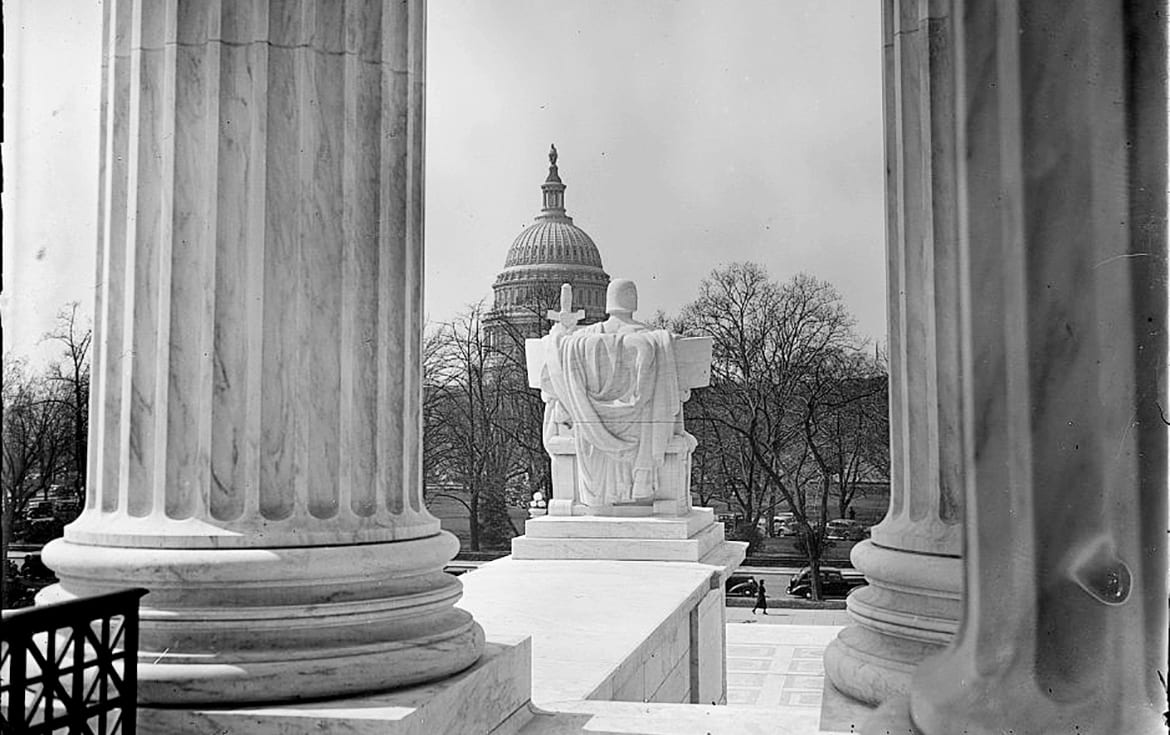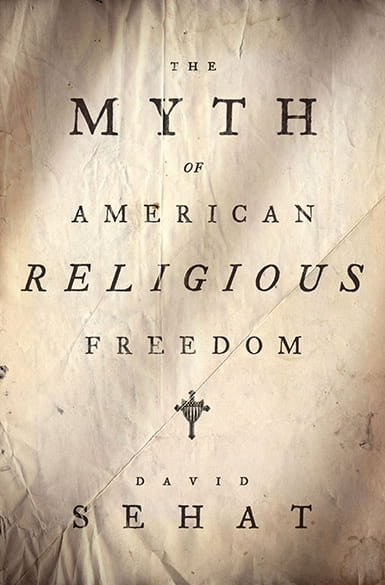
In Review
Church-State Confusion Persists
Capitol building, seen from the Supreme Court, 1937. Library of Congress Prints and Photographs Division
By David D. Hall
The history of Christianity in colonial and modern America defies every boundary. Sponge-like, it absorbs, preserves, and refracts the complexities of that history, which is why any attempt to isolate a single factor is problematic. In his still prescient 1929 book, The Social Sources of Denominationalism, the theologian H. Richard Niebuhr acknowledged this complexity in the service of an ethical critique of Protestant denominationalism. Of the six sources he identified that contribute to denominational divides, two concerned social rank or class (“the disinherited,” the “middle class”), a third, the factor of “sectionalism,” and a fourth, immigration. His other two were “the color line,” or race, and “nationalism,” which we would probably rephrase as a mixture of national and ethnic identities.
Niebuhr wrote in the service of a theological project, an attempt to expose the complicities of church and culture. Saying this does not fault his analysis, which seems uncannily telling in 2016. Yet in his case, as in those of historians who write about the separation of church and state, the past is being used to validate a certain politics. Inevitably, it seems, we are being asked to regret and remedy something that the past contains.
David Sehat’s Myth of American Religious Freedom is a perfect example of an agenda-framed book, an agenda embedded in its title. Exposing a “myth” is an approach favored by all sorts of historians; type “myth of the Old South” into a search engine and you will be flooded with examples. Another excellent example of this genre is John T. Noonan’s Lustre of Our Country: The American Experience of Religious Freedom (1998); in a delightful chapter, Noonan employs the fictive voice of Alexis de Tocqueville’s sister to expose Tocqueville’s misperceptions about the workings of voluntary religion in Democracy in America (1835; 1840), misperceptions rooted in the politics of religion in his native France. Philip Hamburger’s Separation of Church and State (2002) did present-day historians the service of showing how the influx of Catholic immigrants in the middle of the nineteenth century prompted advocates of Protestantism to rally around the “separation of church and state” as a means of stigmatizing the Christianity of these immigrants. The irony is obvious, given that these Protestants had no intention of giving up their privileged situation.

The Myth of American Religious Freedom by David Sehat
Now, in The Myth of American Religious Freedom, another version of disenchantment unfolds, this time in service of the argument that ours is, or should be, a society in which religion should have no connections with the civil state because “religious authority” has been used to obstruct the “expansion of our civil rights.” The story unfolds in four parts. After a brief riff on the founders, we encounter the “establishmentarians” in the early to mid-nineteenth century who defend regulation of the Sunday Sabbath and insert their version of morality into a nascent public school system and, more generally, into public discourse. Then come the “liberals” and social scientists who pull apart morality and religion, followed by a “retrenchment,” when the establishmentarians make something of a comeback (the mid-twentieth century), followed by fresh outbursts of secularism and the attempts of the Supreme Court to figure out the religious clauses of the First Amendment, a story Sehat carries down to the present.
In Sehat’s narrative, evildoers clog the period following the Second World War, one of them Billy Graham, whose evasions about race and other matters are highlighted in a way that deserves to be compared with Grant Wacker’s careful review of Graham and race in America’s Pastor (2014). The “myth” in question is that religious freedom grew stronger and stronger over the course of the nineteenth and twentieth centuries as, one by one, the obstacles to it were removed by the logic of secular progress. This, then, is a book in service of the argument that we would all be better off with a secularized civil state that curtailed the authority of religion in our public life.
My sentiments about such a story are, to say the least, mixed—mixed because I absorbed a version of the establishmentarian stance as a childhood member of the Presbyterian Church in the United States, which eventually repaired the schism that brought it into being.1 And, to this day, I admire several of its ethical imperatives, one of them an insistence on loving others, and another, a recognition that the scramble for ever-greater wealth and power is inherently at odds with “the good.” Still another reason I feel mixed about this argument is because some establishmentarians contributed to anti-slavery movements in ways this book does not acknowledge. Establishmentarians also fought the project of Indian removal that some national leaders embraced and enacted, Andrew Jackson doing so in defiance of the Supreme Court. When it comes to racial discrimination, you don’t have to be a historian by trade to discover that there is more than enough ugliness to go around (in secular as well as religious institutions).
As for the social scientists who discerned a brave new world of “social” everything (and whose ties to Protestantism are scanted in this book), my reaction is similar: I may owe the secularism of my employer to a Protestant liberalism with one root in positivist social sciences, but neither this liberalism nor the social sciences are of much help to me as a historian of Christianity. These camps have too often misread the versions of the past I find so endlessly challenging to interpret, because their core categories are deliberately antagonistic to what happened before 1700, or even before 1950. I feel this tension whenever I encounter Protestant versions of apocalypticism, which crop up everywhere in the present as well as in the past. To treat these as nonsense, as some scholars past and present do, is immediately to close us off from vast stretches of religious experience.
Despite my caveats, Sehat’s is a praiseworthy book. When we finally reach the modern Supreme Court and how it has been deciding cases that involve religion, we learn that the justices are making up a past to suit their purposes. According to Sehat, this is as true of the libertarians as of the quasi-establishmentarians with whom he disagrees. A 1961 opinion authored by Justice Hugo Black on behalf of a liberal interpretation of the Constitution is, we learn, “intellectually evasive and historically misinformed,” an example of “historical amnesia” based on “false history” (246). The 1962 decision which made official prayer in public schools unconstitutional, known as Engel v. Vitale, another “liberal” decision, involved a “confused and contradictory logic” and, like its sequels, included historically inaccurate reasoning (248–49). When the Court came into the hands of conservatives, on the other hand, the version of the past Sehat condemns is “a vehicle for false nostalgia” (269). Occasionally, Sehat discerns something better happening. But a fully informed, fully historical understanding of church and state seems to defy the capacity of the justices.
Nonetheless, Sehat believes that an intelligible version of the past, a version favoring his critique of religious authority, can and should be the basis of Supreme Court decisions. Why is this not happening, and why, almost daily, are lower courts wrestling with how to preserve or disentangle the religious and the civil or secular? History is part of the answer, as the leaders of the early republic welcomed an intertwining marriage of the two. Nothing in the First Amendment prohibits a wide range of accommodations for religion. Although the Supreme Court significantly diminished the government’s obligation to accommodate religion in Employment Division v. Smith (1990), accommodation persists in certain ways in the federal system, e.g., in tax exemptions and chaplaincies for our armed forces and in the laws of most states through Religious Freedom Restoration provisions put in place in 1993 to negate Smith.
History is part of the answer in a second respect; our nation has known none of the interreligious or secular-religious warfare of the kind that provoked the rise of anticlerical, secular, and democratic movements in nineteenth-century Western Europe. Both sides in our civil war were fervently Protestant and small-d democratic, and Catholic-Protestant antagonism, although painfully real, never alienated either side from the civil state. Another reason we have been spared interconfessional conflict is the ease with which Christian-linked themes infiltrated the meaning of “America.” “God Bless America,” which continues to be sung in Blue states as well as Red, may be the best example of this melding. This synthesis is not my cup of tea, but I appreciate its generous understanding of Christianity (now that Catholics are fully “American”). Indeed, its vagueness helps explain why, in the interviews Robert Putnam and his fellow researchers conducted for American Grace: How Religion Divides and Unites Us (2010), Christians across the entire spectrum of denominational and confessional commitments endorsed religious practice as voluntary, or a matter of free choice.
The deeper confusion that affects the Supreme Court and flourishes within the wider public is what we mean by religion. As a legal scholar of church and state remarked to me some years ago, the Supreme Court doesn’t want to define what it means but must do so inadvertently. “Public” or “secular” may seem more obvious, but, as the disputes over freedom of speech in shopping malls have revealed, the definition of public has its own fuzzy edges, in part because of the agility of the “religious” to worm its way into public spaces. Why, then, is there so much noise at the present moment about “free exercise” or, as some have renamed it, “free expression” and “religious liberty”? The short answer is that the state has begun to intrude on religious practice in new ways in the service of advancing secular or civil rights. For various reasons, we may agree or disagree about the scope of this program, but the constitutional question is how emphatically the nation-state is entitled to do so. Are there no limits to the reach of its authority?
The founders wanted to keep religion from messing up the civil state, and vice versa; they also delegated a great deal of authority over such matters to each of the states. Now, much of what they laid out has been overturned or modified. Ours has become a weak federal system overshadowed by a strong central state. Should we hasten down this path and eliminate every vestige of religious authority over our common lives and, if so, what becomes of the ethical or normative substance of that commonality? However we answer this question, its import may explain why the national state and churches are often at odds with each other, and why the Supreme Court continues to tie itself in knots around these issues.
David D. Hall is Bartlett Professor of New England Church History Emeritus at Harvard Divinity School. His current project is a general history of Puritanism in England, Scotland, and New England from 1550 to 1700, to be published by Princeton University Press.
Please follow our Commentary Guidelines when engaging in discussion on this site.

